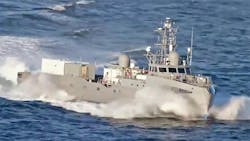Navy calls-out 49 companies to provide sensors and machine autonomy for unmanned surface vessels (USVs)
WASHINGTON – U.S. Navy unmanned vehicles experts plan to spend nearly a billion dollars among 49 companies over the next five years for a major effort to design next-generation unmanned surface vessels (USVs).
Officials of the Naval Sea Systems Command in Wash. announced Wednesday that these 49 companies will share contracts with a potential cumulative value of $982.1 million to support the Unmanned Surface Vehicle Family of Systems.
These companies each will receive $1,000 up-front, and through 2030 will compete for individual delivery orders for integrated unmanned surface vessels, USV propulsion systems, sensor and sensor-processing payloads, and other aspects of advanced USV design.
The project's contractors will provide products and services within six areas: payloads; non-payload sensors; mission support systems; autonomy and vehicle control systems; ashore and host platform elements; and logistics and sustainment for the Unmanned Surface Vehicle Family of Systems.
Four years ago Naval Sea Systems Command awarded contracts collectively worth $982.1 million to 40 other companies to support the Unmanned Surface Vehicle Family of Systems.
The 49 companies selected Friday to participate in the Unmanned Surface Vehicle Family of Systems project are:
-- Anduril Industries Inc. in Costa Mesa, Calif.;
-- Applied Research Associates Inc. (ARA) in Albuquerque, N.M.;
-- Asymmetric Technologies LLC in Dublin, Ohio;
-- AT&T Government Solutions in Oakton, Va.;
-- Atlas Tech in North Charleston, S.C.;
-- Autonodyne LLC in Boston;
-- Beast Code LLC in Fort Walton Beach, Fla.;
-- Mettle Ops in Sterling Heights, Mich.;
-- Bollinger Shipyards Lockport LLC in Lockport, La.;
-- CACI Inc. Federal in Chantilly, Va.;
-- Carnegie Robotics LLC in Pittsburgh;
-- Cydecor Inc. in Arlington, Va.;
-- DELTA Resources Inc. in Alexandria, Va.;
-- Fairbanks Morse LLC in Beloit, Wis.;
-- Teledyne FLIR Surveillance Inc. in North Billerica, Mass.;
-- General Atomics Aeronautical Systems Inc. in Poway, Calif.;
-- GIRD Systems Inc. in Cincinnati;
-- Herren Associates Inc. in Washington;
-- Paste link hereHoneywell Aerospace in Clearwater, Fla.;
Related: Pentagon gets serious about unmanned surface vessels
-- IERUS Technologies Inc. in Huntsville, Ala.;
-- Integer Technologies LLC in Columbia, S.C.;
-- KIHOMAC Inc. in Reston, Va.;
-- Leonardo Electronics US Inc. in Huntsville, Ala.;
-- MAK Technologies Inc. in Cambridge, Mass.;
-- Marine Ventures International Inc. in Stuart, Fla.;
-- Marinette Marine Corp. in Marinette, Wis.;
-- Metron Inc. in Reston, Va.;
-- Microsoft Corp. in Redmond, Wash.;
-- Murtech Inc. in Glen Burnie, Md.;
Related: Unmanned vehicle systems: ready for takeoff
-- NewSat North America LLC in Indian Harbour Beach, Fla.;
-- Noblis MSD LLC in Philadelphia;
-- Accenture Federal Services in McLean, Va.;
-- Ocean Specialists Inc. in Stuart, Fla.;
-- PACMAR Technologies LLC in Honolulu;
-- Persistent Systems LLC in New York;
-- Physical Sciences Inc. in Andover, Mass.;
-- Prescient Edge Corp. in McLean, Va.;
-- Programs Management Analytics & Technologies (PMAT) Inc. in San Diego;
-- Reliability & Performance (R&P) Technologies LLCReliability & Performance (R&P) Technologies LLC in Dublin, Pa.;
-- Saab Inc. in East Syracuse, N.Y.;
-- Scientific Systems Co. Inc. in Woburn, Mass.;
-- Secmation LLC in Raleigh, N.C.;
-- SES Space & Defense in Reston, Va.;
-- SIMIS Inc. in Portsmouth, Va.;
-- Sparton DeLeon Springs LLC in De Leon Springs, Fla.
-- Systems and Proposal Engineering Co. (SPEC) in Manassas, Va.;
-- Systems Technology & Research Inc. in Huntsville, Ala.;
-- TDI Technologies Inc. in King of Prussia, Pa.; and
-- Triton Systems Inc. in Chelmsford, Mass.
Unmanned Surface Vehicle Family of Systems payloads include components that the USV will carry in addition to what is necessary to operate and navigate the vessel. Payloads will interface with the USV and help carry out lethal or non-lethal missions.
Example payloads are towed sonars, data recorders, payload controllers, and signal processors, and may include optical, acoustic, infrared, radar, radio, underwater electromagnetic, deployed systems, towed systems, and homing & docking interfaces.
Towed sonars will have an actively controlled towed body with automatic depth or altitude control based on the mission and will detect, classify, and locate bottom, close-tethered, and volume mines in one pass.
Acoustic sensors will include side-looking sonars with synthetic aperture sonar (SAS), volume search sonar, and an optical identification sensor to identify bottom mines.
Contractors will conduct payload research, handle cyber security and trusted computing, and provide build-to-print technical data packages for follow-on competition, production, modification, integration, and test.
Non-payload sensors are necessary for basic operation of the USV, and may include forward-look sonar, transducers, hydrophones, automatic identification systems, imaging, radar, transponders, conductivity, temperature and depth, sub-bottom profiler, Doppler velocity log, Global Positioning System (GPS), and altimeters.
Mission-support systems will provide physical, electrical, and data interfaces to payload systems. Examples are payload launch and recovery, mine countermeasures unmanned surface vehicle minesweeping payload delivery system, minehunting, and mine neutralization.
Machine autonomy and vehicle control systems enable the USV to develop and select among different courses of action based on the USV’s knowledge and understanding of the situation. These systems will enable the USV to monitor and conduct the mission.
Ashore and host platform elements are the systems and subsystems that enable a USV to interface, launch, and recover from an ashore and or host platform, and may include launch and recovery hardware, data interface systems, hardware interface systems, electrical interface systems, local command and control, energy system charging and refueling equipment, onboard storage equipment, maintenance equipment, and tendering for a USV.
Elements include USV communications between the USV and its ashore host, USV to USV, and USV to its payloads, such as radios, cross-domain solutions, enclosures, power supplies, and communications software.
Logistics and sustainment activities are services necessary to maintain optimal performance of the USVs, payloads, and related components throughout the program life cycle.
On these contracts the Unmanned Surface Vehicle Family of Systems companies will do the work in various locations of the contiguous U.S., and should be finished by February 2025. With options, work could continue until February 2030.
For more information contact Naval Sea Systems Command online at www.navsea.navy.mil/Media/News/Article/2329287/navy-awards-first-usv-family-of-systems-contract-delivery-orders.
About the Author
John Keller
Editor-in-Chief
John Keller is the Editor-in-Chief, Military & Aerospace Electronics Magazine--provides extensive coverage and analysis of enabling electronics and optoelectronic technologies in military, space and commercial aviation applications. John has been a member of the Military & Aerospace Electronics staff since 1989 and chief editor since 1995.

